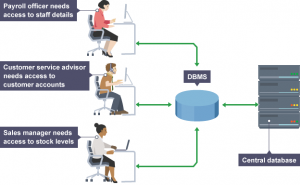Database
A database is a collection of information that is organized so that it can easily be accessed managed, and updated. In one view, databases can be classified according to types of content: bibliographic, full-text, numeric and images.
Data Storage Hierarchy
| Level 0 | Bit A | Single binary digit (0 or 1) |
| Level 1 | Character | Multiple related bits are combined to form a character (byte) |
| Level 2 | Field | Multiple related characters are combined to form a field |
| Level 3 | Record | Multiple related fields are combined to form a record |
| Level 4 | Table | Multiple records are combined to form a table |
| Level 5 | Database | Multiple related tables are integrated to form a database |
Components of Database System
Users- People who interact with the database:
- Application Programmers
- End Users
- Data Administrators
Software- Lies between the stored data and the users:
- DBMS
- Application Software
- User Interface
Quality of Information
- Accuracy
- Times
- Relevancy
- Completeness
Database Application
- MS – Access
- My-SQL
- SQL
- Oracle
Why to use DBMS?
- Data Independence
- Efficient Data Access
- Data Integrity
- Data Administration
- Concurrent Access and Crash Recovery
- Reduced Application Development Time
Database Management System
A database management system (DBMS ) is a collection of software programs that allow a user to define the data types, structures, and constraints for the data; construct permanent storage for the data; and manipulate data by query and update operations. In the specific case of relational databases, the database management software is known as a relational database management system RDBMS.
Database Model
A database model is a type of data model that determines the logical structure of a database and fundamentally determines in which manner data can be stored, organized and manipulated. The most popular example of a database model is the relational model, which uses a table based format.
Hierarchical Model
In a hierarchical model, data is organized into a tree like structure , implying a single parent for each record. A sort field keeps sibling records in a particular order. Hierarchical structures were widely used in the early mainframe database management systems.
Network Model
The network model expands upon the hierarchical structure, allowing many to many relationships in a tree like structure that allows multiple parents. It was most popular before being replaced by the relational model.
Relational Model
A relational database contains multiple tables, each similar to the one in the “flat” database model. One of the strengths of the relational model is that, in principle, any value occurring in two different records (belonging to the same table or to different tables), implies a relationship among those two records. A key that can be used to uniquely identify a row in a table is called a primary key. Keys are commonly used to join or combine data from two or more tables.
Object Oriented Model
The object oriented programming paradigm was applied to database technology, creating a new database model known as object databases for storing objects in a database.
Advantages of DBMS
- Make an easy to add new data.
- Make easy to modify (change) the database.
- Make easy to delete existing data.
- Organized the data in proper sequence.
- It reduces the data redundancy to a large extent.
- It can control data inconsistency to a large extent.
- Make easy to access the data for the user.
- Allow multiple users to be active at one time; data in the database may be shared among several users.
- Protecting data against unauthorized access (security).
- Allow for growth in the database system.
Disadvantages of DBMS
- Complex to understand and implement
- Costly
- Too many rules
- Fast changing technology
- Chance of losing the data
- Chance of data leakage and hacking
- Unavailability of trained manpower.
Data Security
- Encryption
- Strong User Authentication
- Backup Solutions
- Firewall
Some Questions
What is Database? What is the use of Database in Bank?
What is Database Management System? What are the different types of Database model?
What types of database model is used on modern banking system? Justify your answer.







Top comments (0)